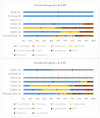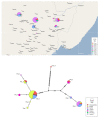Identification, Pathogenicity, and Genetic Diversity of Fusarium spp. Associated with Maize Sheath Rot in Heilongjiang Province, China
- PMID: 36142733
- PMCID: PMC9501324
- DOI: 10.3390/ijms231810821
Identification, Pathogenicity, and Genetic Diversity of Fusarium spp. Associated with Maize Sheath Rot in Heilongjiang Province, China
Abstract
Maize sheath rot is a prevalent maize disease in China. From 2020 to 2021, symptomatic samples were collected from the main maize-growing regions of Heilongjiang province. To clarify the population and genetic diversity, as well as the virulence of pathogens responsible for maize sheath rot, a total of 132 Fusarium isolates were obtained and used for follow-up studies. Ten Fusarium species were identified based on morphological characteristics, and phylogenetic analysis was conducted using the TEF-1α gene sequences, including F. verticillioides (50.00%), F. subglutinans (18.94%), the Fusarium incarnatum-equiseti species complex (14.39%), F. temperatum (5.30%), F. acuminatum (3.03%), F. solani (2.27%), F. sporotrichioides (2.27%), F. tricinctum (1.52%), F. asiaticum (1.52%), and F. proliferatum (0.76%). All 10 Fusarium species could produce oval-to-annular lesions on maize sheath, and the lesions were grayish yellow to dark brown in the center and surrounded by a dark gray-to-dark brown halo. Of these, F. tricinctum and F. proliferatum showed significantly higher virulence than the other Fusarium species. In addition, haplotype analysis based on the concatenated sequences of the ITS and TEF-1a genes showed that 99 Fusarium isolates which belonged to the Fusarium fujikuroi species complex-consisting of F. verticillioides isolates, F. subglutinans isolates, F. temperatum isolates, and F. proliferatum isolates-could be grouped into 10 haplotypes, including 5 shared haplotypes (Haps 1, 2, 4, 5, and 6) and 5 private haplotypes (Haps 3, 7, 8, 9, and 10). Furthermore, the F. verticillioides clade in the haplotype network was radial with the center of Hap 2, suggesting that population expansion occurred. This research showed that Fusarium species associated with maize sheath rot in Heilongjiang province are more diverse than previously reported, and this is the first time that F. subglutinans, F. temperatum, F. solani, F. sporotrichioides, F. tricinctum, and F. acuminatum have been confirmed as the causal agents of maize sheath rot in Heilongjiang province.
Keywords: Fusarium spp.; genetic diversity; haplotype analysis; maize; pathogenicity test.
Conflict of interest statement
The authors declare that there are no conflict of interest.
Figures






Similar articles
-
Fusarium Species Associated with Maize Leaf Blight in Heilongjiang Province, China.J Fungi (Basel). 2022 Nov 6;8(11):1170. doi: 10.3390/jof8111170. J Fungi (Basel). 2022. PMID: 36354937 Free PMC article.
-
Fungal Pathogens Associated with Crown and Root Rot in Wheat-Growing Areas of Northern Kyrgyzstan.J Fungi (Basel). 2023 Jan 16;9(1):124. doi: 10.3390/jof9010124. J Fungi (Basel). 2023. PMID: 36675945 Free PMC article.
-
Morphological characterization, pathogenicity screening, and molecular identification of Fusarium spp. isolates causing post-flowering stalk rot in maize.Front Microbiol. 2023 Mar 31;14:1121781. doi: 10.3389/fmicb.2023.1121781. eCollection 2023. Front Microbiol. 2023. PMID: 37065162 Free PMC article.
-
Cost-effectiveness of using prognostic information to select women with breast cancer for adjuvant systemic therapy.Health Technol Assess. 2006 Sep;10(34):iii-iv, ix-xi, 1-204. doi: 10.3310/hta10340. Health Technol Assess. 2006. PMID: 16959170
-
Systemic pharmacological treatments for chronic plaque psoriasis: a network meta-analysis.Cochrane Database Syst Rev. 2021 Apr 19;4(4):CD011535. doi: 10.1002/14651858.CD011535.pub4. Cochrane Database Syst Rev. 2021. Update in: Cochrane Database Syst Rev. 2022 May 23;5:CD011535. doi: 10.1002/14651858.CD011535.pub5. PMID: 33871055 Free PMC article. Updated.
Cited by
-
A Study of Soil-Borne Fusarium Wilt in Continuous Cropping Chrysanthemum Cultivar 'Guangyu' in Henan, China.J Fungi (Basel). 2023 Dec 27;10(1):14. doi: 10.3390/jof10010014. J Fungi (Basel). 2023. PMID: 38248924 Free PMC article.
-
Relationship between Dubas Bug (Ommatissus lybicus) Infestation and the Development of Fungal-Induced Leaf Spots in Date Palms (Phoenix dactylifera).Insects. 2023 Mar 14;14(3):283. doi: 10.3390/insects14030283. Insects. 2023. PMID: 36975969 Free PMC article.
References
-
- Li S. Review of maize market in 2020–2021 and prospect in 2021–2022. China Pig Ind. 2022;17:29–33.
-
- Wang Q.L., Zhang N.N., Liu H. An empirical study on Maize supply response in China under the background of Market-oriented Reform-based on Provincial Panel data of three Northeast provinces from 2008 to 2019. Agric. Resour. Reg. China. 2021;42:145–152.
-
- Xu X.D., Jiang Y., Wang L.J., Dong H.Y., Hu L., Lu G.Z., Liu Z.H. Corn Sheath Rot—A New Disease Found in China. Sci. Agric. Sin. 2008;41:3083–3087.
-
- Hu L., Xu X.D., Jiang Y., Wang L.J., Xu J., Zhao Y. Study on biological characteristics of corn sheath rot causal agent. Maize Sci. 2008;16:131–134.
MeSH terms
Grants and funding
LinkOut - more resources
Full Text Sources
Miscellaneous

